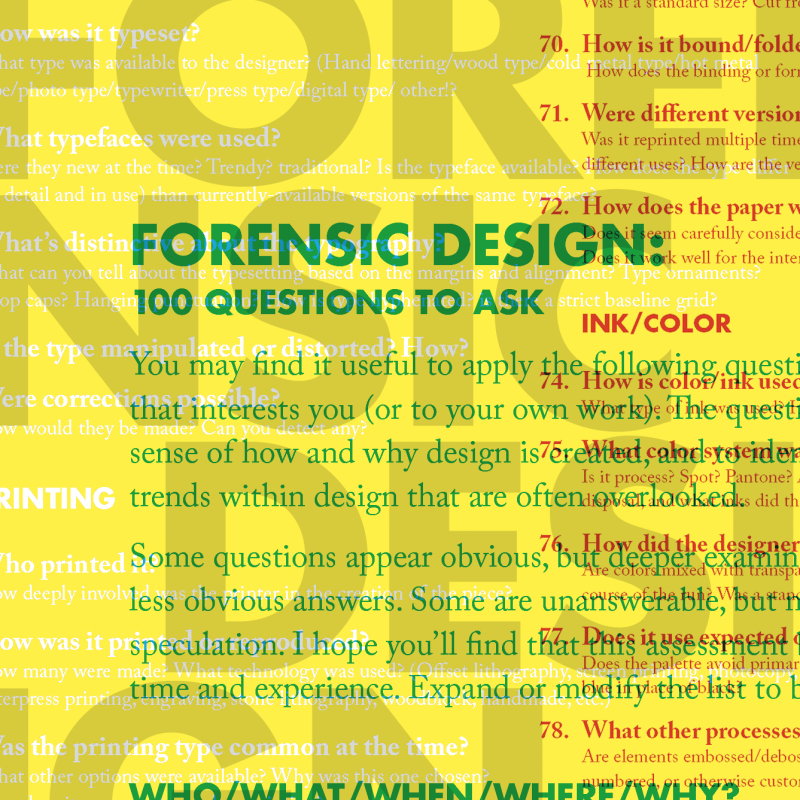Forensic Design is a method of gathering meaningful inspiration from existing design, without being superficial or imitative.
Designers should look for inspiration everywhere, and it’s often useful to study existing work. Unfortunately, design is very much about “first impressions.” We see only the finished result, unaware of unseen factors such as process, people, language, culture, materials, commerce, and technology.
“Forensic Design” asks questions that reveal the process that leads to the desired result.
The study of graphic design generally presents reproductions of finished works, presented as the magical visions of arbitrary “great men” pigeonholed into movements, locations, and periods. A gallery context is a terrible way to experience art, let alone design. Design has far-more-relevant goals than impressing other designers. Even worse, when we study “vernacular” or “outsider” design, we often only skim the surface, to snipe superficial ideas.
The key to Forensic Design is looking beyond the surface to understand the whole process. To this end, we ask questions. Good designers already do this subconsciously, but by developing a conscious framework, the exercise becomes more fruitful, providing a deeper understanding and leading to more interesting ideas. Rather than aping design gimmicks, we can integrate the original designers’ process and intent into our own, and create something original and honest.
After years of making a conscious effort to think about design, I’ve assembled a list of specific questions. It’s a work in progress, and will never be complete, but it’s my hope that creative professionals will use it as a starting point for their own investigations. My list focuses on print design, but these concepts can be applied to any creative endeavor: industrial design, architecture… even writing and music!
Here’s the current list of questions (v4.0)
The list of questions above is the first “published” version, as first presented to Mark Franz’ senior design class at Ohio University in late 2020, along with a longe audiovisual presentation about Forensic Design.
More background, and a statement about intellectual property:
In my 35-plus years of design and production work. I’ve been lucky to experience several shifts in design technology. My interest in design history and technology eventually drove me to reverse-engineer any printed piece I came across, to the degree that co-workers started jokingly calling me a “forensic designer.” Aside from being a reasonably impressive parlor trick, this skill proved to be very useful in my day-to-day work, especially at Field Notes.
As a poseur suburban punk-rocker at heart, I’ve always been averse to “high design culture.” Big design conferences and lectures remind me of arena rock shows, an expensive and unfulfilling one-way flow of already-familiar information. My interest in letterpress printing led me to Hamilton Woodtype Museum’s annual Wayzgoose conference, which I’d argue is a fantastic model for a productive and egalitarian exchange of ideas. I’d love to present “Forensic Design” in similar forums, a handful of designers at a time, where, like Wayzgoose, I can learn as much from the “audience” as they learn from me.
With that in mind, I’m sharing my ideas here with the associated risks of making them public. I put a good amount of thought and work into this project, and I continue to develop it with an eye to eventual publication. I encourage you to use the process for self-improvement, but I ask that you not share these ideas for profit. I claim copyright and reserve all my rights regarding the term “Forensic Design” and the associated texts and concepts.
I’m happy to talk about Forensic Design anywhere, anytime: please reach out if you’d like me to speak to a group (students, designers, etc), or if you have any interest in helping me pursue/develop/publish these ideas.
Forensic Design by Bryan Bedell is licensed under CC BY-NC-SA 4.0
